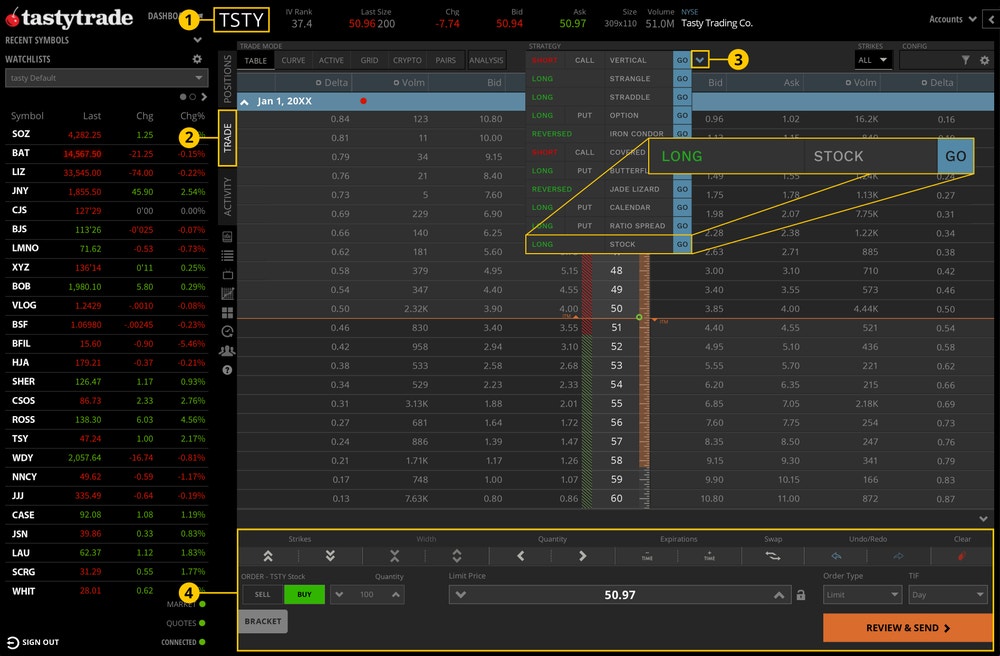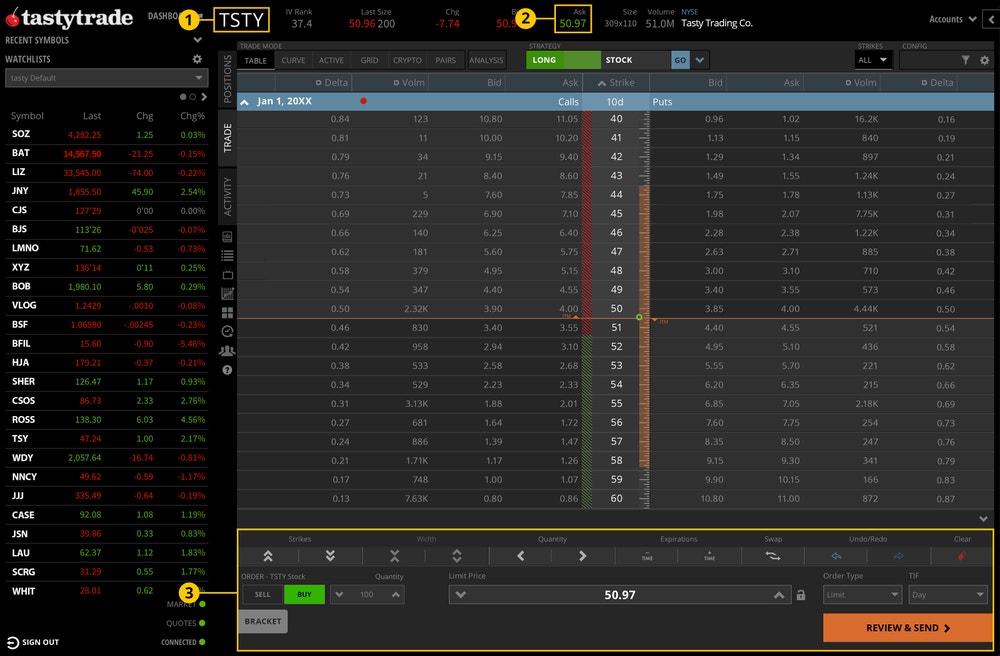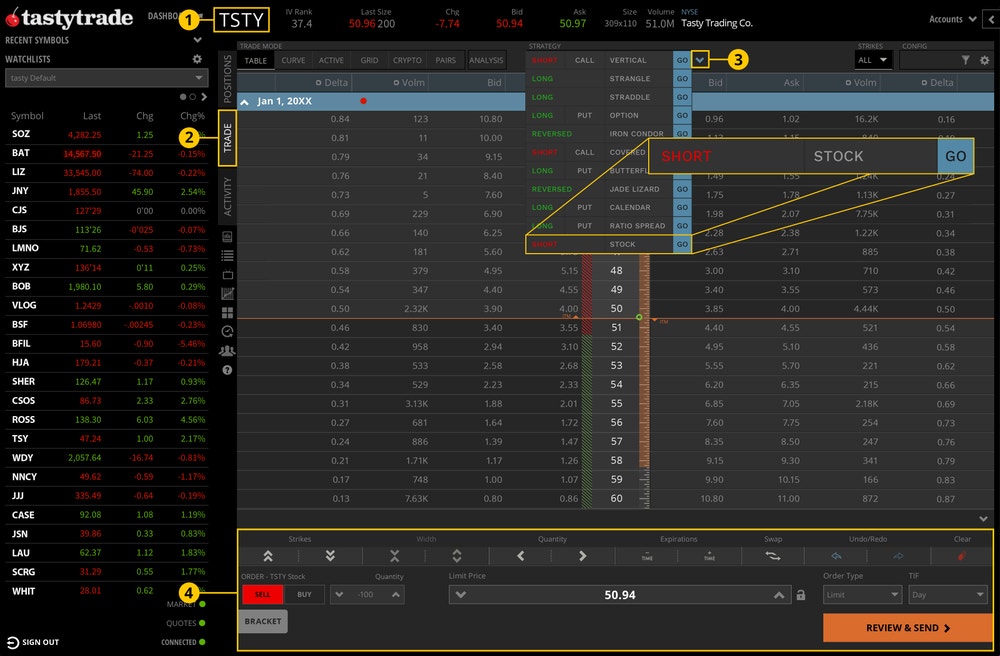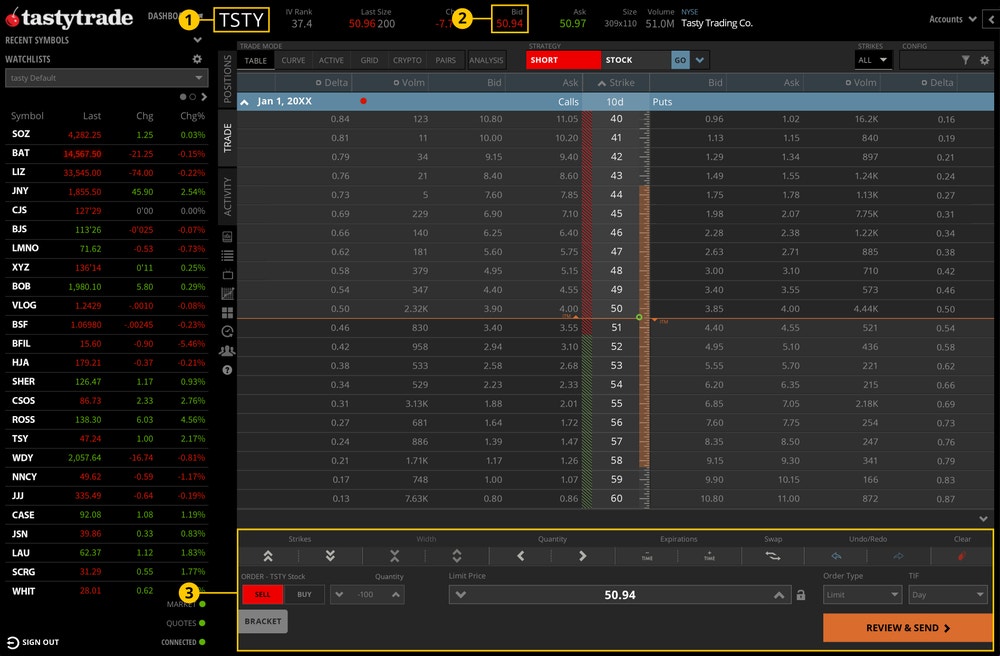How to Buy and Sell Stocks and ETFs (Long and Short)
Contents
Stocks and ETFs
Do you have a hunch on a company, a sector, or a specific industry? Investors can gain direct exposure by investing in a company’s common stock or through an exchange-traded fund (ETF) for diversified exposure in a sector or industry. Before diving into all the different types of stocks available to investors, let's briefly cover the directional stance investors can take to benefit from investing in stocks.
Investors can take one of two stances when establishing a stock position: long or short. Visit the tastytrade Help Center to learn more about placing a long or short stock order on the tastytrade trading platform.
Long Stock Example
- Buy to open 100 shares of XYZ @ $45
- Cost: $4,500 debit
Directional Bias | Bullish |
Buying Power Effect | Cash & IRA
Margin Account
|
Max Profit | Unlimited Example: Buy to Open 100 shares of XYZ @ $45 Sell to Close 100 shares of XYZ @ $50 Profit: +$500 |
Max Loss (only achieved if the stock goes to $0) | Cost of the shares Example: Buy to Open 100 shares of XYZ @ $45 XYZ drops to $0 Loss: -$4,500 |
Breakeven Price | Per share purchase price |
Account Type Required |
|
Other Names |
|
* Margin requirement for a stock greater than $5 without elevated requirements and has margin privileges. Please visit the tastytrade Help Center to learn more about long stock buying power requirements in a margin account.
** Purchasing stock on margin requires at least $2,000 in marginable equity (cash and eligible marginable positions).
How to Buy Stock
Using the Strategy Menu
- Enter a symbol.
- Navigate to the Trade tab.
- Locate the Stock strategy and click each column to display Long, Stock, and Go.
- Go to the order ticket to determine the quantity, price, time-in-force (TIF), etc., before clicking "Review & Send" to send the order.

Building it Manually
- Enter the symbol.
- Click the Ask price
- Go to the order ticket to determine the quantity, price, time-in-force (TIF), etc., before clicking "Review & Send" to send the order.

Short Stock Example
- Sell to open 100 shares of XYZ @ $45
- Effect: $4,500 credit
Directional Bias | Bearish |
Buying Power Effect | Cash & IRA
Margin Account
|
Max Profit (only achieved if the stock goes to $0) | Share price x number of shares $45 x 100 = $4,500 credit received $4,500 - $0 stock price = $4,500 max profit |
Max Loss | Unlimited |
Breakeven Price | Purchase price |
Account Type Required |
|
Other Names |
|
* The initial requirement for short stock is typically 50% or $10 a share, whichever is greater. Some stocks may have elevated margin requirements.
** Selling stock requires a margin account with "The Works" with least $2,000 in marginable equity (cash and eligible marginable positions).
How to short stock
Using the Strategy Menu
- Enter a symbol.
- Navigate to the Trade tab.
- Locate the Stock strategy and click each column to display Short, Stock, and Go.
- Go to the order ticket to determine the quantity, price, time-in-force (TIF), etc., before clicking "Review & Send" to send the order.

Building it Manually
- Enter the symbol.
- Click the Bid price.
- Go to the order ticket to determine the quantity, price, time-in-force (TIF), etc., before clicking "Review & Send" to send the order.

All investments involve risk of loss. Please carefully consider the risks associated with your investments and if such trading is suitable for you before deciding to trade certain products or strategies. You are solely responsible for making your investment and trading decisions and for evaluating the risks associated with your investments.
Trading in a margin account is not suitable for all investors. It is important that investors understand the risks involved in trading securities on margin prior to investing in a margin account. Please read the Margin Disclosure Statement here.